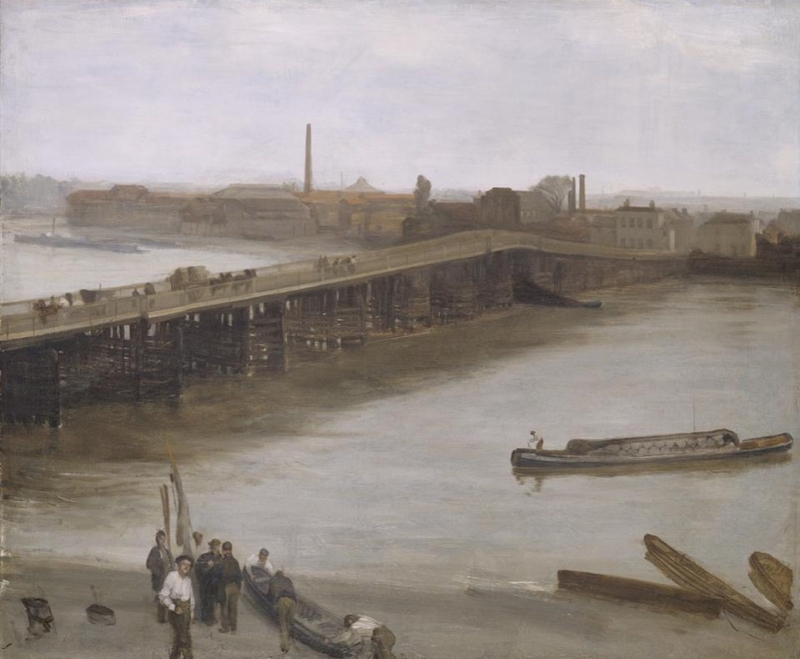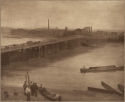Home > Catalogue > People > Alexander Ionides (related works) > Catalogue entry
Composition
Possibly lacking the money, time, or inclination to buy a new canvas of suitable dimensions, Whistler turned an old one on its side, and painted right across his own self-portrait. An X-ray shows the self-portrait beneath the barge and water on the right. 1
The X-ray is discussed in a blog entry by Margaret MacDonald and Nadine Loach as follows:
'Whistler’s oil paintings of the Thames, combining closely observed realistic views, expressive brushwork and atmospheric colour, reward close examination. However, they can also conceal surprises, the ghostly records of earlier work. X-rays of two paintings by Whistler have resulted in a remarkable discovery. The paintings are Brown and Silver: Old Battersea Bridge (Addison Gallery of American Art) and The Last of Old Westminster (Boston Museum of Fine Arts).
It has long been known, from an X-ray, that there is a self-portrait of the artist, painted at right angles to the Thames riverscape, under Brown and Silver: Old Battersea Bridge.
It shows Whistler at work, painting with brush in hand, but was left unfinished and partly rubbed down. Nevertheless it is a vivid portrayal of the young artist, and was probably painted either in Paris or – more likely – in London. Either he was not satisfied with the portrait or he needed a canvas to start the painting Old Battersea Bridge, ... If the Bridge is looked at under raking light, traces of the ghostly Whistler can still be seen.
… The Last of Old Westminster was also painted over a portrait, that of a seated woman, possibly a woman reading, which was also painted at right angles to the bridge, and partly rubbed down. ...
Although it is difficult to be certain, the woman, as seen in the x-ray, looks like Whistler’s Irish model Joanna Hiffernan. A detail from a drypoint portrait of ‘Jo’, reversed, is illustrated below for comparison.
The two portraits could be considered a pair: they are close in size, Brown and Silver: Old Battersea Bridge being 63.5 x 76.2 cm and The Last of Old Westminster, slightly different in proportion, at 60.96 x 78.1 cm. It is possible that they recorded a significant stage in the relationship between artist and model, as partners in the creation of works of art.
However, either these intimate portraits were sacrificed in order to make way for more saleable paintings of the river Thames, or Whistler simply felt that the portraits were not working out. Despite his close relationship with Jo, his model, mistress and partner, or perhaps because of it, Whistler may have felt that he could not complete, hang or exhibit two such personal images. And so they were sacrificed for two immensely saleable, exhibitable – and very beautiful – paintings of Thames bridges.' 2
Technique
It is painted fairly thickly in muted colours (mostly shades of brown and greyish blue) on a fine weave canvas. There are some pentimenti: a small boat on the shore to right of centre has been painted out, and there are signs of alterations around the figures at left. The details of the distant city, the piles of the bridge and the passers-by thereon, as well as the workmen in the foreground, are painted with what was, for Whistler, exceptional care. The brushstrokes of the earlier self-portrait, despite it having been rubbed down, are at times visible, complicating the textures of the Thames painting.
Conservation History
It was painted on canvas, which was subsequently mounted on prestwood.
Notes:
1: MacDonald & de Montfort 2013 [more] , pp. 20-22.
2: MacDonald, Margaret and Nadine Loach, 'Whistler's Ghosts', James McNeill Whistler and his Art, A blog about James McNeill Whistler, March 2014, jmcnwhistler.wordpress.com/2014/03.
Last updated: 19th December 2020 by Margaret








